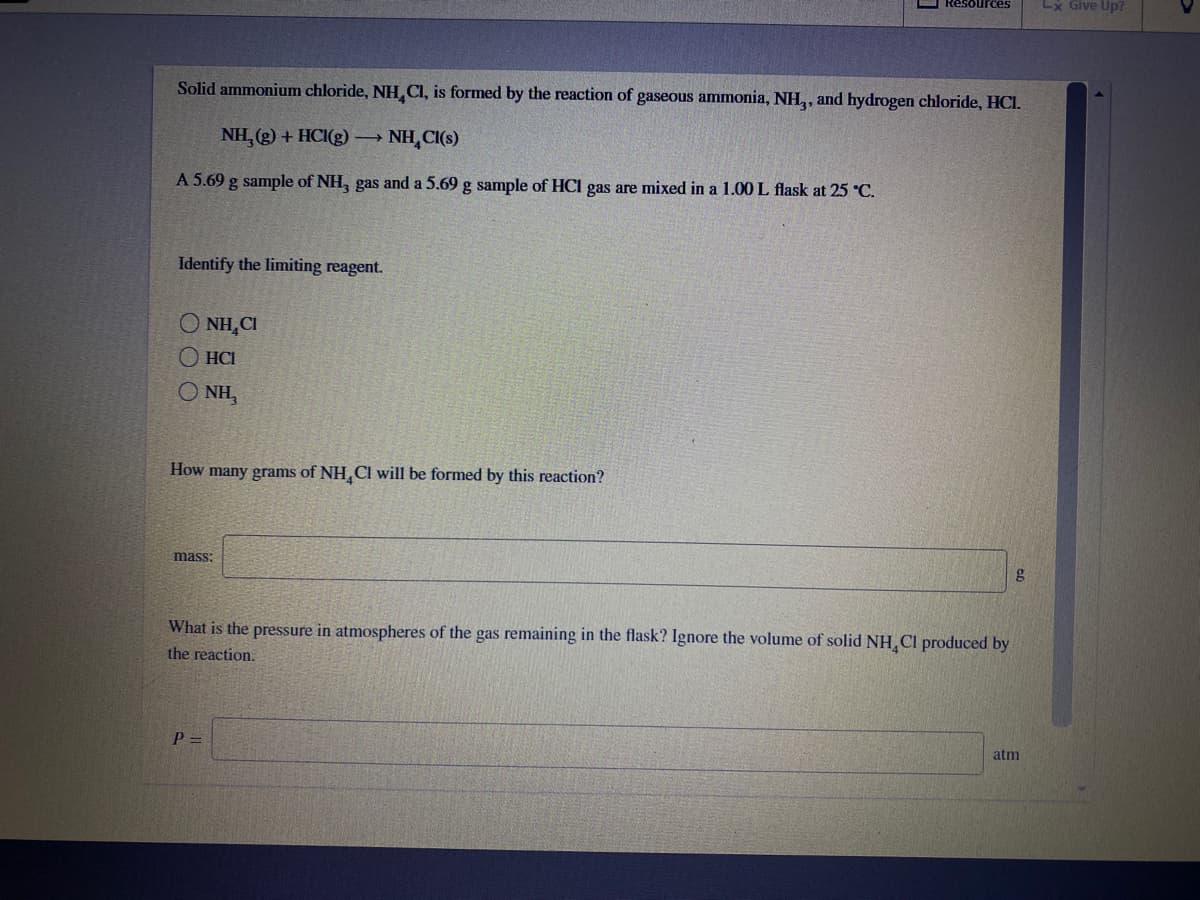Solid ammonium chloride, NH,CI, is formed by the reaction of gaseous ammonia, NH,, and hydrogen chloride, HCI. NH, (g) + HCI(g) NH,CI(s) A 5.69 g sample of NH, gas and a 5.69 g sample of HCI gas are mixed in a 1.00L flask at 25 C. Identify the limiting reagent. O NH,CI О НС O NH, How many grams of NH, Cl will be formed by this reaction? mass: What is the pressure in atmospheres of the gas remaining in the flask? Ignore the volume of solid NH,Cl produced by the reaction. P = atm
Solid ammonium chloride, NH,CI, is formed by the reaction of gaseous ammonia, NH,, and hydrogen chloride, HCI. NH, (g) + HCI(g) NH,CI(s) A 5.69 g sample of NH, gas and a 5.69 g sample of HCI gas are mixed in a 1.00L flask at 25 C. Identify the limiting reagent. O NH,CI О НС O NH, How many grams of NH, Cl will be formed by this reaction? mass: What is the pressure in atmospheres of the gas remaining in the flask? Ignore the volume of solid NH,Cl produced by the reaction. P = atm
Introduction to General, Organic and Biochemistry
11th Edition
ISBN:9781285869759
Author:Frederick A. Bettelheim, William H. Brown, Mary K. Campbell, Shawn O. Farrell, Omar Torres
Publisher:Frederick A. Bettelheim, William H. Brown, Mary K. Campbell, Shawn O. Farrell, Omar Torres
Chapter6: Solutions And Colloids
Section: Chapter Questions
Problem 6.109P
Related questions
Question

Transcribed Image Text:Sources
Lx Give Up?
Solid ammonium chloride, NH, Cl, is formed by the reaction of gaseous ammonia, NH,, and hydrogen chloride, HCI.
NH, (g) + HCI(g) NH,CI(s)
A 5.69 g sample of NH, gas and a 5.69 g sample of HCI gas are mixed in a 1.00 L flask at 25 °C.
Identify the limiting reagent.
O NH,CI
O HCI
O NH,
How many grams of NH Cl will be formed by this reaction?
mass:
What is the pressure in atmospheres of the gas remaining in the flask? Ignore the volume of solid NH,CI produced by
the reaction.
P =
atm
Expert Solution
This question has been solved!
Explore an expertly crafted, step-by-step solution for a thorough understanding of key concepts.
Step by step
Solved in 4 steps with 3 images

Knowledge Booster
Learn more about
Need a deep-dive on the concept behind this application? Look no further. Learn more about this topic, chemistry and related others by exploring similar questions and additional content below.Recommended textbooks for you

Introduction to General, Organic and Biochemistry
Chemistry
ISBN:
9781285869759
Author:
Frederick A. Bettelheim, William H. Brown, Mary K. Campbell, Shawn O. Farrell, Omar Torres
Publisher:
Cengage Learning


Chemistry: An Atoms First Approach
Chemistry
ISBN:
9781305079243
Author:
Steven S. Zumdahl, Susan A. Zumdahl
Publisher:
Cengage Learning

Introduction to General, Organic and Biochemistry
Chemistry
ISBN:
9781285869759
Author:
Frederick A. Bettelheim, William H. Brown, Mary K. Campbell, Shawn O. Farrell, Omar Torres
Publisher:
Cengage Learning


Chemistry: An Atoms First Approach
Chemistry
ISBN:
9781305079243
Author:
Steven S. Zumdahl, Susan A. Zumdahl
Publisher:
Cengage Learning

Chemistry
Chemistry
ISBN:
9781305957404
Author:
Steven S. Zumdahl, Susan A. Zumdahl, Donald J. DeCoste
Publisher:
Cengage Learning

Introductory Chemistry: A Foundation
Chemistry
ISBN:
9781337399425
Author:
Steven S. Zumdahl, Donald J. DeCoste
Publisher:
Cengage Learning

Chemistry & Chemical Reactivity
Chemistry
ISBN:
9781337399074
Author:
John C. Kotz, Paul M. Treichel, John Townsend, David Treichel
Publisher:
Cengage Learning